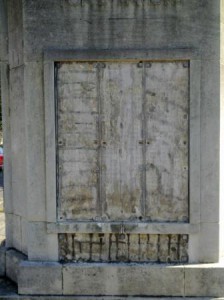Remembrance Day (also known as Poppy Day and Armistice Day) is a memorial day observed in Commonwealth countries since the end of World War I to remember the members of their armed forces who have died in the line of duty. This day, or alternative dates, are also recognised as special days for war remembrances in many non-Commonwealth countries.
Remembrance Day is observed on 11 November to recall the official end of World War I on that date in 1918; hostilities formally ended “at the 11th hour of the 11th day of the 11th month” of 1918 with the German signing of the Armistice (“at the 11th hour” refers to the passing of the 11th hour, or 11:00 a.m.)
The day was specifically dedicated by King George V on 7 November 1919 as a day of remembrance of members of the armed forces who were killed during World War I. This was possibly done upon the suggestion of Edward George Honey to Wellesley Tudor Pole, who established two ceremonial periods of remembrance based on events in 1917.
The red remembrance poppy has become a familiar emblem of Remembrance Day due to the poem “In Flanders Fields”. These poppies bloomed across some of the worst battlefields of Flanders in World War I, their brilliant red colour an appropriate symbol for the blood spilled in the war.
In the United Kingdom, although two minutes of silence are observed on 11 November itself, the main observance is on the second Sunday of November, Remembrance Sunday. Ceremonies are held at local war memorials, usually organised by local branches of the Royal British Legion, an association for ex-servicemen. Typically, poppy wreaths are laid by representatives of the Crown, the armed forces, and local civic leaders, as well as by local organisations including ex-servicemen organisations, cadet forces, the Scouts, Guides, Boys’ Brigade, St John Ambulance and the Salvation Army. A minute’s or two minutes’ silence is also frequently incorporated into church services. Further wreath-laying ceremonies are observed at most war memorials across the UK at 11 a.m. on the 11th of November, led by the Royal British Legion. The beginning and end of the two minutes’ silence is often marked in large towns and cities by the firing of ceremonial cannon and many employers and businesses invite their staff and customers to observe the two minutes’ silence at 11:00 a.m.
The First Two Minute Silence in London (11 November 1919) was reported in the Manchester Guardian on 12 November 1919:
“The first stroke of eleven produced a magical effect. The tram cars glided into stillness, motors ceased to cough and fume, and stopped dead, and the mighty-limbed dray horses hunched back upon their loads and stopped also, seeming to do it of their own volition. Someone took off his hat, and with a nervous hesitancy the rest of the men bowed their heads also. Here and there an old soldier could be detected slipping unconsciously into the posture of ‘attention’. An elderly woman, not far away, wiped her eyes, and the man beside her looked white and stern. Everyone stood very still … The hush deepened. It had spread over the whole city and become so pronounced as to impress one with a sense of audibility. It was a silence which was almost pain … And the spirit of memory brooded over it all.”









